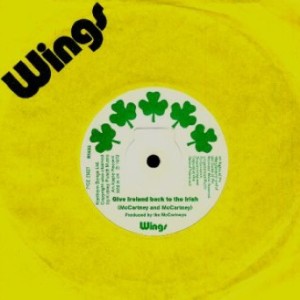 Paul’s record company EMI reluctantly agreed to let him and his band Wings record and release the protest song, but warned it would be banned. Which, of course, it was — by the BBC, Radio Luxembourg and the U.K.’s Independent Television Authority. But despite its lack of airplay it managed to chart – reaching the #1 spot in Ireland and Spain, #16 in the U.K., and #21 in the U.S. Like John and Yoko, whose “Two Virgins” album was banned for full frontal nudity on its cover, Paul now had his own censored piece of work, thus qualifying him for membership in the rock-n-roll rabble-rousers society (at least for a short time).
Paul’s record company EMI reluctantly agreed to let him and his band Wings record and release the protest song, but warned it would be banned. Which, of course, it was — by the BBC, Radio Luxembourg and the U.K.’s Independent Television Authority. But despite its lack of airplay it managed to chart – reaching the #1 spot in Ireland and Spain, #16 in the U.K., and #21 in the U.S. Like John and Yoko, whose “Two Virgins” album was banned for full frontal nudity on its cover, Paul now had his own censored piece of work, thus qualifying him for membership in the rock-n-roll rabble-rousers society (at least for a short time).
Most people aren’t aware that John had also recorded two songs in response to Britain’s brutal treatment of Ireland: “Sunday Bloody Sunday” and “The Luck of the Irish,” both featured on his June 1972 LP “Some Time in New York City.”
John said he was inspired to write “The Luck of the Irish” after taking part in a 1971 London protest march in support of Ireland. Said John, “I’m a quarter Irish or half Irish or something, and long, long before the trouble started, I told Yoko that’s where we’re going to retire, and I took her to Ireland. We went around Ireland a bit and we stayed in Ireland and we had a sort of second honeymoon there. So I was completely involved in Ireland.”
Many critics lauded John’s empathetic song supporting the Emerald Isle – in the ‘Pool they told us the story / how the English divided the land / of the pain and the death and the glory / and the poets of old Ireland – but bemoaned Yoko’s contribution to the lyrics, which included mentions of shamrocks, rainbows and leprechauns, and a hope for the “world [to] be one big Blarney stone.”
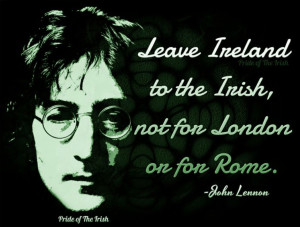 In response to Bloody Sunday, John participated in a protest outside the New York office of Britain’s national airline, BOAC. Soon after, he wrote “Sunday Bloody Sunday.” Commenting on his motivation to pen the song, he said: “Most other people express themselves by shouting or playing football at the weekend. But me, here I am in New York and I hear about the 13 [sic] people shot dead in Ireland, and I react immediately. And being what I am, I react in four-to-the-bar with a guitar break in the middle.”
In response to Bloody Sunday, John participated in a protest outside the New York office of Britain’s national airline, BOAC. Soon after, he wrote “Sunday Bloody Sunday.” Commenting on his motivation to pen the song, he said: “Most other people express themselves by shouting or playing football at the weekend. But me, here I am in New York and I hear about the 13 [sic] people shot dead in Ireland, and I react immediately. And being what I am, I react in four-to-the-bar with a guitar break in the middle.”
Interestingly, John recorded his song during the same month that Paul recorded “Give Ireland Back to the Irish.” But Paul beat John to the punch, releasing his single four months before Lennon’s song appeared on his “Some Time in New York City” album. The two were still in a period of backbiting and competition following the Beatles’ 1970 breakup, so John no doubt got his Irish up over Paul’s single, which was more timely and garnered much attention.
John’s original family surname was O’Lennain, the Gaelic word for love. But unlike most people who boast of even the most minuscule amount of Irish blood flowing through their veins, John rarely made a great deal of fanfare about his roots.
For the record, Paul is three-quarters Irish and George Harrison was one-quarter Irish. Poor Ringo hasn’t a drop of Irish blood, but we love him all the same.
Here’s John’s “Sunday Bloody Sunday”:
And “The Luck of the Irish,” minus Yoko’s singing:
And Paul’s “Give Ireland Back to the Irish”:
© Dana Spiardi, March 17, 2013
]]>
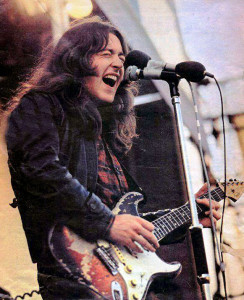 “Do you not get it, lads? The Irish are the blacks of Europe.” That’s a wonderful line from The Commitments, a sweet little film about a ragtag assortment of Dubliners who form a soul band. Just think about it: like African Americans, the Irish have lived The Blues for centuries. And it shows…in their soul-fire poetry, prose, and music. So, you’re probably thinking “Van Morrison.” No. Today I want you to think “Rory Gallagher.” Heard of him? I hope so. But if not, listen up: he was one of the greatest blues-rock guitarists of all time and is a national folk hero in Ireland. Today would have been his 67th birthday, so let’s take a moment to pay homage to this passionate workingman of the guitar.
“Do you not get it, lads? The Irish are the blacks of Europe.” That’s a wonderful line from The Commitments, a sweet little film about a ragtag assortment of Dubliners who form a soul band. Just think about it: like African Americans, the Irish have lived The Blues for centuries. And it shows…in their soul-fire poetry, prose, and music. So, you’re probably thinking “Van Morrison.” No. Today I want you to think “Rory Gallagher.” Heard of him? I hope so. But if not, listen up: he was one of the greatest blues-rock guitarists of all time and is a national folk hero in Ireland. Today would have been his 67th birthday, so let’s take a moment to pay homage to this passionate workingman of the guitar.
During Rory’s career he released 12 studio albums with sales exceeding 30 million copies worldwide. In 1971 he beat out Eric Clapton as Melody Maker International’s Top Musician of the Year. In fact, Clapton has said that Rory was responsible for “getting me back into the blues.” The Rolling Stones once considered hiring him to replace guitarist Mick Taylor, who quit the band in 1974. The only reason he’s not better known in America is because – to quote the name of one of Rory’s famous albums – he went against the grain when it came to self-promotion, studio gimmicks, groupie baiting, and rock star posturing.
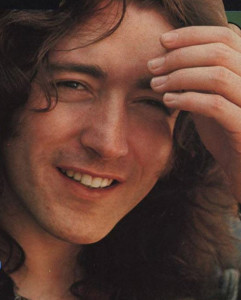 Born in Ballyshannon and raised in Cork, Rory was a self-taught guitarist. His parents didn’t own a record player. Like many future musicians growing up in the bland land of U.K. radio, he received his early blues-rock education by listening to R&B greats on that premiere music school of the airways, Radio Luxembourg. He started touring as a young teen with a cheap guitar, hitting the clubs of Ireland and England – even Hamburg, Germany, where The Beatles cut their teeth. He used the money he made from gigging to make payments on a 1961 Sunburst Fender Stratocaster. He worked that guitar so hard during his marathon performances that the alkaline from his sweat stripped the instrument of its paint. That guitar became his trademark.
Born in Ballyshannon and raised in Cork, Rory was a self-taught guitarist. His parents didn’t own a record player. Like many future musicians growing up in the bland land of U.K. radio, he received his early blues-rock education by listening to R&B greats on that premiere music school of the airways, Radio Luxembourg. He started touring as a young teen with a cheap guitar, hitting the clubs of Ireland and England – even Hamburg, Germany, where The Beatles cut their teeth. He used the money he made from gigging to make payments on a 1961 Sunburst Fender Stratocaster. He worked that guitar so hard during his marathon performances that the alkaline from his sweat stripped the instrument of its paint. That guitar became his trademark.
In 1966 he formed a critically acclaimed power trio called Taste. They released several LPs, played regular gigs at London’s home of the blues, The Marquee Club, and opened for supergroups like Cream and Blind Faith. John Lennon praised the band, telling New Musical Express that Taste was a “bright spot” among the copycat guitar acts of 1969. Rory’s popularity rose during his solo career in the 1970s. He was one of the few artists with the balls to regularly perform in Northern Ireland’s capital of Belfast during the troubled days of street warfare with British troops. A true virtuoso, he influenced guitarists like Queen’s Brian May, U2’s The Edge, and Slash of Guns N’Roses. In fact, Slash has appealed to his fans, via Twitter, urging them to sign an online petition to help get Rory inducted into the Rock and Roll Hall of Fame.
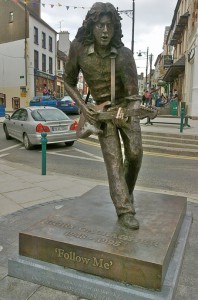 To me, his most endearing quality was his total devotion to his craft and dislike of celebrity. In an era of rock star flamboyance, his stage uniform consisted of simple denim jackets and plaid shirts. He had no interest in hit singles, and stood up to his record label bosses who insisted he release the powerful “Edged in Blue” from his 1976 “Calling Card” LP. Performing was his pure passion. Rory told Rolling Stone magazine in 1972, “It seems a waste to me to work and work for years, really gettin’ your music together; then to make it big, as some people do, and just turn into some sort of personality.”
To me, his most endearing quality was his total devotion to his craft and dislike of celebrity. In an era of rock star flamboyance, his stage uniform consisted of simple denim jackets and plaid shirts. He had no interest in hit singles, and stood up to his record label bosses who insisted he release the powerful “Edged in Blue” from his 1976 “Calling Card” LP. Performing was his pure passion. Rory told Rolling Stone magazine in 1972, “It seems a waste to me to work and work for years, really gettin’ your music together; then to make it big, as some people do, and just turn into some sort of personality.”
It’s a pity Rory died so young – at age 47 in 1995 – from an infection (MRSA) following liver transplant surgery. He left behind no wife or children, but lives on through a legion of dedicated fans and followers. In 2010 the people of Ballyshannon unveiled a life-size bronze statue of him. Rory memorials can also be found in Cork and Dublin. And in 2002 his country featured him on a postage stamp. The Irish will always refer to him as “the people’s guitarist.”
Below are some great clips of the beautiful, phenomenal Rory. Click here to sign an online petition to help get him inducted into the Rock and Roll Hall of Fame.
© Dana Spiardi, March 2, 2014
]]>